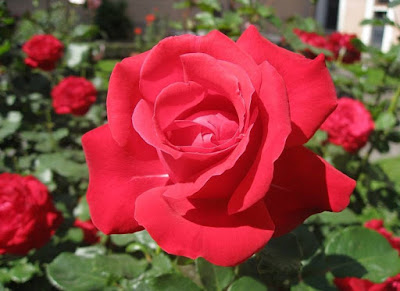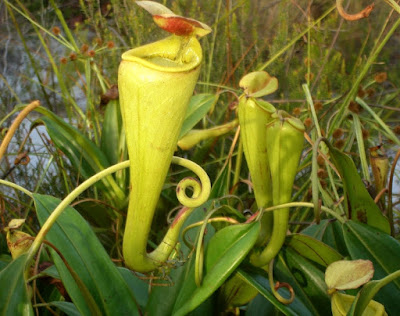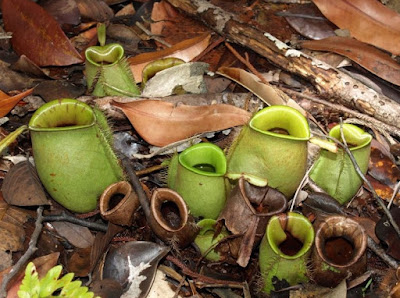Nepenthes Flower - Plants of this Nepenthes plants bag is an ornamental plant
that is quite unique and exotic. This unique shape makes nepenthes plants look
more attractive for the ornamental planting flowers in the yard of our home.
But unfortunately this nepenthes ornamental plant species can only be found in certain
places.
Villagers are generally not familiar with the term nepenthes
plant, they mostly only know the term Nepenthes plants bag. This type of
ornamental plant is quite popular Nepenthes plants among the community, both
among lower class society or upper class society.
Nepenthes plants flower has a very wide spread from the
beach to the highlands, because this is nepenthes divided into two types of
highland and lowland species, although most species grow in the highlands. The
recorded species grew at the highest altitude was N. lamii ie at an altitude of
3.520 m.
Type of Nepenthes Flowers
Here are some types of Nepenthes plants bag plants, which
look amazing and seductive, but who would have thought this enchanting plant is
a great predator.
1. Nepenthes Madagascariensis
Nepenthes madagascariensis is one of two species of
Nepenthes plants pockets found on Madagascar Island, its habitat is on the east
of the island.
2. Nepenthes Jacquelineae
Nepenthes jacquelineae is a sumatra endemic bag of Sumatran,
and is one of the most spectacular Nepenthes plants bags on the island.
3. Nepenthes Appendiculata
Nepenthes appendiculata is the only known tropical plant of
the middle Saraose Hose Mountains, Borneo, growing at an altitude of 1450-1700
m Meters above sea level. This species is characterized by the addition of an
enlarged gland on the lower surface of the lid, and is named appendiculata
4. Nepenthes Aristolochioides
The place where this plant grows at an altitude of 1800-2500
m above sea level. This kind of Nepenthes plants-type flower has a very strange
shape than in general, with an almost vertical opening in the trap bag.
This
plant was first collected by Willem Meijer on August 5, 1956. The holotype,
Meijer 6542, was collected from Gunung Tujuh in Jambi at an altitude of 2000 m.
5. Nepenthes Jamban
The Nepenthes plants Jamban bag is one of the most
endangered species of Nepenthes plants bag (Nepenthes) that is endemic to North
Sumatra.
The name of this species is taken from the Indonesian language which
refers to the form of a pouch that resembles a toilet or toilet. The species
was first collected on April 22, 2005 from southern Padang Sidempuan.
6. Nepenthes Villosa
This Nepenthes plants bag is located in Mount Kinabalu and
Mount Tambuyukon on Borneo Island
7. Nepenthes Ceciliae
Nepenthes ceciliae is a Nepenthes species that has not yet
been described by its taxon. This is a Filipino endemic species located on the
island of Mindanao, it lives at an altitude of 1500-1800 m above sea level. His
discovery was announced on the internet in August 2011.
8. Nepenthes Rajah
Nepenthes Rajah is also an endemic plant in Mount Kinabalu
and Mount Tambuyukon on the island of Borneo. It belongs to an endangered
species.
9. Nepenthes Maxima
Nepenthes maxima grows in Sulawesi Island, Maluku Islands,
and Papua Island
10. Nepenthes Ampullaria
The above Nepenthes is a Sumatran endemic sac plant that
lives at altitudes between 2400 to 2900 m above sea level. No varieties of N.
above have been found. The use of the above species name is derived from the
Indonesian language "above".
In fact, it violates the preposition
rule in Bahasa Indonesia, but demands in the use of binomial nomenclature which
requires only two names, namely the genus and species names, so that the words
"di" and "above" are forced to be combined.
11. Nepenthes Truncata
Named so because its leaf-like shape is truncated.Nepenthes
truncata is one of the Nepenthes plants bag species which is an endemic
carnivorous plant on the island of Mindanao in the Philippines.
This type of
Nepenthes plants bag grows at an altitude between 0-1500 m. This plant was once
encountered trapping rats.
12. Nepenthes Khasiana
Nepenthes Khasiana Is the only Nepenthes plants bag species
originating from India.
13. Nepenthes Rafflesiana
Pocket Nepenthes plants Rafflesia Has a wide spread area,
including Borneo, Sumatra, Peninsular Malaysia, and Singapore. Nepenthes
rafflesiana has many variations (second after Nepenthes mirabilis) with some of
them already found.
In Borneo alone, at least four different varieties have
been found. Its giant form alone can rival the species of Nepenthes rajah in
size.
14. Nepenthes Dragon
Dragon Nepenthes plants Bag is a plant of semi-endemic bag
Bukit Barisan, Sumatra. The unique shape that distinguishes this type of
Nepenthes plants flower is apparently similar to the body of a bottle and an
organ that is shaped like a snake tongue that comes out from the bottom of the
pouch cover.
The name of the dragon is taken from the Indonesian language which
refers to the shape of the cover of the sac and external body and its large
size. This name also refers to folklore in Bukit Barisan which is touted as a
dragon habitat in the past.
15. Nepenthes Pitopangii
Nepenthes pitopangii is endemic on the island of Sulawesi.
Nepenthes pitopangii was discovered in 2006 with the discovery of a specia in
Lore Lindu National Park.
16. Nepenthes Termostato
This species is the most distinctive of the genus Nepenthes,
can be found in Borneo, Sumatra, Thailand, Peninsular Malaysia, Singapore,
Maluku Islands, and New Guinea. Nepenthes ampullaria is also known to be the
only "vegetarian" Nepenthes plants baggage species, due to the
pockets of this type of Nepenthes plants bag.
It does not have a nectar gland
on the pouch lips so rarely do the insects get stuck in the bag. Generally most
of the objects found in the bag are rotting leaves, animal dung, small branches
and rain water.
How, interested in planting this ornamental plant of this
flower? guaranteed insects that move in your house will be reduced drastically.
Read also other articles:
























